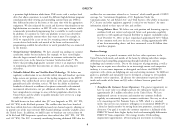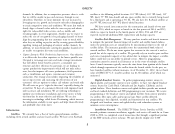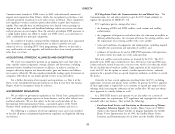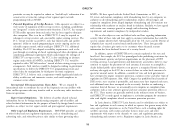DIRECTV 2012 Annual Report Download - page 28
Download and view the complete annual report
Please find page 28 of the 2012 DIRECTV annual report below. You can navigate through the pages in the report by either clicking on the pages listed below, or by using the keyword search tool below to find specific information within the annual report.DIRECTV
channels. In addition, due to competitive pressures, there is a risk satellites at the following orbital locations: 101⬚ WL (three), 110⬚ WL (one), 119⬚
that we will be unable to pass such increases through to our WL (one), 95⬚ WL (one-leased) and one spare satellite that is currently being leased
subscribers. Therefore, we must minimize the cost increases by by a third party and is operating at 56⬚ EL. We also have five Ka-Band satellites at
leveraging our size, growth and attractive subscriber demographics our 99⬚ WL (two) and 103⬚ WL (three) orbital locations.
to attain competitive terms and conditions. We must also work to We have entered into contracts for the construction and launch of two new
closely align a channel’s value with the costs we pay and obtain satellites: D14, which we expect to launch in the first quarter of 2014, and D15,
rights for value-added video services, such as mobile and which we expect to launch in the fourth quarter of 2014. D14 and D15 are
streaming rights, in every negotiation. Another way we expect to expected to provide additional HD, replacement and backup capacity.
reduce the rate of cost growth is by packaging channels to better
Satellite Risk Management. We may purchase in-orbit and launch insurance
align the programming that our customers want to watch with
to mitigate the potential financial impact of in-orbit and satellite launch failures
what they are willing to pay for and by securing greater flexibility
unless the premium costs are considered to be uneconomical relative to the risk of
regarding tiering and packaging of content and/or channels. In
satellite failure. The insurance generally covers the unamortized book value of
addition, we may discontinue carrying less popular channels if we
covered satellites. We do not insure against lost revenues in the event of a total or
are unable to negotiate fair terms and conditions.
partial loss of the capacity of a satellite. We generally rely on in-orbit spare satellites
•Capture Enterprise-Wide Productivity Improvements. Our objective and excess transponder capacity at key orbital slots to mitigate the impact a satellite
is to deliver the best video experience at the lowest possible cost. failure could have on our ability to provide service. However, programming
Our goal is to manage our costs and make strategic investments continuity cannot be assured in all instances or in the event of multiple satellite
that will deliver future benefits, preserve a sustainable cost losses. Launch insurance typically covers the time frame from ignition of the launch
structure and drive efficiency. In particular, we are looking to vehicle through separation of the satellite from the launch vehicle. In the past, we
capture productivity improvements which will not only reduce have launched satellites without insurance. As of December 31, 2012, the net book
costs, but also improve call center performance, field operations value of DIRECTV U.S.’ in-orbit satellites was $1,344 million, all of which was
such as installations and repairs, retention and customer uninsured.
satisfaction. Our strategy also includes improving the reliability of
our set-top receivers and increasing the effectiveness of our Digital Broadcast Centers. To gather programming content, ensure its
customers’ self-care options to reduce call volumes and truck rolls. digital quality, and transmit content to our satellites, we have two digital broadcast
We will strive to get it ‘‘right the first time’’ especially during the centers, located in Castle Rock, Colorado and Los Angeles, California and six
critical first 90 days of a customer’s lifecycle with improved work uplink facilities. These broadcast centers and uplink facilities provide our national
order accuracy and installation. We are utilizing technology to and local standard-definition and HD programming to our customers. We receive
optimize our technicians’ installation and service routes to help programming at the broadcast centers and uplink facilities from content providers
our front-line be more effective and efficient. We are also via satellite, fiber optic cable and/or special tape. Most satellite-delivered
investing in technology called Active Decisioning, which increases programming is then digitized, encoded and transmitted to our satellites. We
the information available to our agents and helps them effectively designed each broadcast center and uplink facility with redundant systems to
and profitably close deals faster. minimize service interruptions.
Installation Network. The DIRECTV Home Service Provider, or HSP,
Infrastructure network performs customer installation, upgrade, and service call work for us. From
Satellites. We currently have a fleet of twelve geosynchronous satellites, 2008 to 2010, we completed several transactions that brought a significant portion
including eleven owned satellites and one leased satellite. We have seven Ku-Band of this HSP network activity in-house. We now directly employ over 4,000
8
























